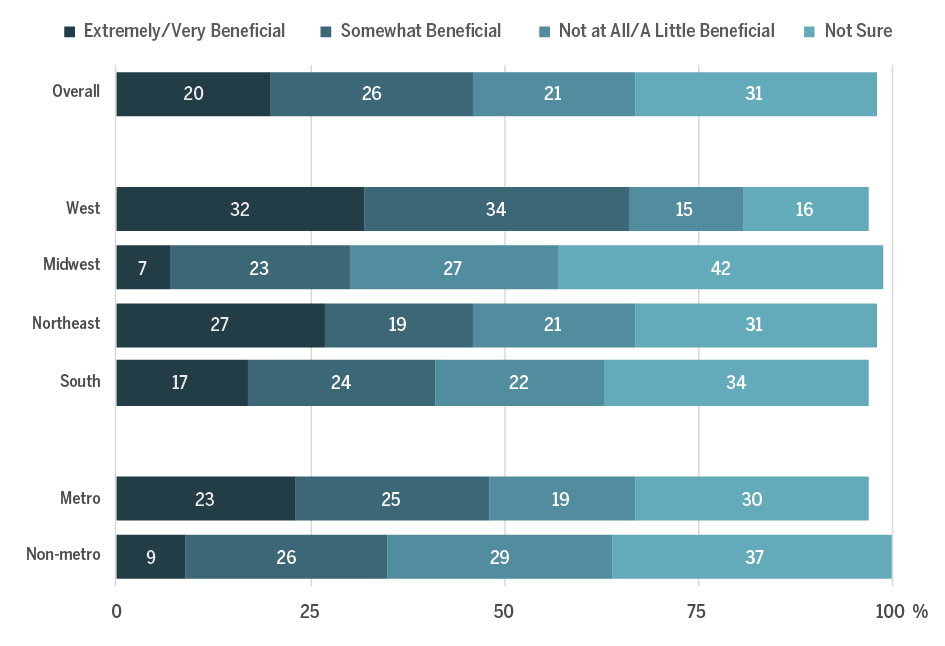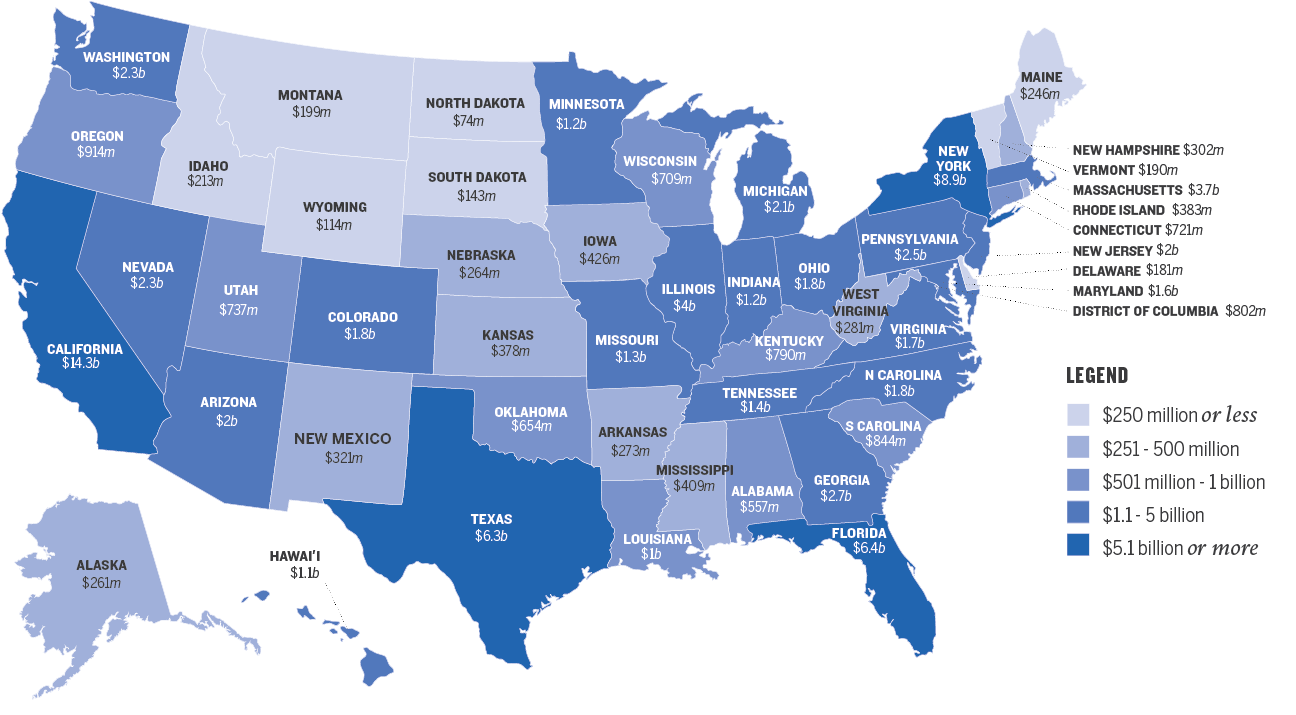The following article is part of an ongoing series of analyses based on the recent Asia Matters for America Public and Elite Opinion poll. See all articles in the series here.
A recent poll conducted by NORC at the University of Chicago, on behalf of the East-West Center, offers insights into the opinions Americans have towards the relationship between the United States and Asia. In surveying both the public, as well as elites[1] this data touches on a topic especially pertinent in the wake of the COVID-19 pandemic, opinions on tourism from the Indo-Pacific.
The tourism industry was drastically harmed by the COVID-19 pandemic, with the impact felt throughout the world. Nations dependent on tourism as a major proportion of their total GDP suffered massive unemployment, and while the United States is not one of these countries, the impact on the industry has still taken its toll. Shrinking a full 48% in 2020, in contrast to the 1% relative growth in 2019 , tourism now only composes 1.71% of the total United States GDP, as compared to 2.92% in 2019. Still, this percentage is a larger share than agriculture, mining, or utilities in the US economy. Therefore, the state of the United States tourism industry is a crucial conversation.
When it comes to the benefit of Asian tourism on local US economies, survey participants (both elites and the general population) were divided on how beneficial it is. When looking at the general public, the West[2] was the only region with a consensus (66%) that believed Asian tourism is at least somewhat beneficial. Compared to the Western United States, every other region had larger proportions of the populations unsure of the benefit of Asian tourism, the largest being the Midwest (42%).
As shown by the chart below, 31% of the general population was unsure of the benefit of Asian tourism within their state. Add together unsure respondents with the proportion to those who see Asian tourism as not beneficial, approximately 52% of the population were unsure or do not believe tourism from Asia benefits their state.
HOW BENEFICAL IS TOURISM FROM ASIA TO THE ECONOMY OF YOUR STATE?
Percent of Adults

The elite population, on average, had a higher percentage of respondents who valued Asian tourism compared to the general population. As shown below, 70% of the elites surveyed found benefit in Asian tourism, a major contrast when viewing the opinions held by the general public. According to the survey, fewer elites living in the Midwest (66%) said tourism is at least somewhat beneficial, compared to 80% of those in the South, 82% of those in the Northeast, and 88% of those in the West. When comparing elites to the general public, it seems to reflect a similar distribution of regional opinions (the West having the highest percentage of respondents who said Asian tourism was beneficial and the Midwest having the lowest), but elites had higher percentages of respondents who said Asian tourism was beneficial.
HOW BENEFICAL ARE TOURISM AND IMMIGRATION FROM ASIA TO THE ECONOMY OF YOUR STATE?
Percent of Elites

The regional differences invite a deeper exploration. Respondents from the Western United States were the largest population in support of Asian tourism, as 66% saw positive benefit. In contrast, only 30% of the Midwest general population saw tourism as beneficial, and this population held the biggest regional proportion of responses of not beneficial, at 27%. The Midwest general population also had the largest proportion of unsure respondents, with 42% of the population answering, ‘Not sure.’
The breakdown of opinions held by the Midwest respondents is very close to the percentages seen when considering the opinions of the non-metropolitan polling results; with only 9% considering it very beneficial, and 37% holding no opinion to the impact of Asian tourism on their economy.
In 2016, the United States saw enormous visitation from the Indo-Pacific, with top visitor countries including Japan (3,717,029 visitors) , China (2,587,968 visitors) , South Korea (2,001,417 visitors), Australia (1,423,898) and India (1,206,225). These countries collectively brought in 10,936,537 tourists in total. Broken down by the map below, Indo-Pacific visitors contributed nearly $90 billion to the US economy in 2016, with almost half of US states receiving at least $1 billion in revenue through Indo-Pacific tourism. When we contrast this from the polling results, we are left with a divide between the impact of visitation from across the Pacific, versus what most people think the impact is.
VISITOR SPENDING FROM THE INDO-PACIFC

What this data possibly shows is a majority of the population is uninformed about the impact of the Indo-Pacific tourist on their local economies. One explanation for these geographical differences is the spending and contributions made by tourists and visitors are centered in specific economies and urban centers. Rural states such as Missouri, Arizona, and Florida all receive over $1 billion each from Indo-Pacific tourism a year, however the general population may find it difficult to understand, or directly see the true impact unless they are in the industry or live in an urban center .
Most importantly, when we look at the region with respondents most unsure about the benefit of Indo-Pacific tourism, the Midwest, we see enormous economic benefits. States like Illinois ($3.9 billion), Ohio ($1.8 billion), Michigan ($1.7 billion), and Minnesota ($1.1 billion) clearly benefit from this relationship, yet this does not reflect public opinion.
The polling and economic data show a disconnect between opinions of the benefit of Asian tourism and the economic impact of Asian tourism. The general population outside of the Western United States does not see the benefit of Asian tourism to their states, even if the benefit is evident in economic data on money spent by Asian tourists. These results could point to a rural vs. urban divide, in which tourist contributions are concentrated in specific urban regions in the state, or to benefits concentrated in certain industries, such as airlines. Initiatives that bridge the gap between Americans and the larger Indo-Pacific are important to communicate how local communities are impacted by such relationships. In the coming years, as we expect tourism to bounce back from the worst impacts of COVID-19, ensuring the US population understands the importance of this industry will be important for economic recovery.
Ryan Ahn Roden is a former participant in the Young Professionals Program at the East-West Center in Washington. He is currently a graduate student at American University's School of International Service.
Asia Matters for America Poll Analysis is a series of short articles exploring the results of the recent survey by the East-West Center and conducted by the NORC at the University of Chicago on American perspectives on US-Asia relations. Authors examine a segment of the results from the report regarding trade, tourism, international students, immigration, human rights, national security, and sister city relationships to attempt to understand how Americans believe Asia matters to their state.
[1] Elites: For the purposes of this survey "Elites" is defined as elected and appointed officials, bureaucrats, and business leaders. 1,446 people representing these three sub-categories answered the survey.
[2] Please refer to the map on page 4 of the report.